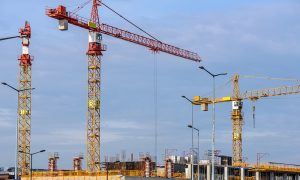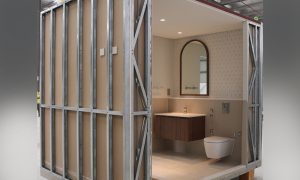The problem of existing building stock
A noticeable shift in trend in the construction sector during 2017 has been a growing awareness among clients and consultants of the ageing building stock in the region. Words like refurbishment, retrofit and re-use have become commonplace in meetings, conferences and debates, and the existing building problem is the elephant in the room that is conveniently avoided when looking at the (over) supply of new builds. Whether you are involved in the operation and maintenance of an existing building, acquiring an asset as a form of investment or considering the purchase of a home, many properties are reaching the stage where an enhanced understanding of condition is critical to ensure lifespan is prolonged, investment is not wasted and the buildings that shape our region keep up with the demands of an aspiring smart city.
Let’s consider the most challenging requirement of a truly smart city: sustainability. The extreme environmental conditions in this region, coupled with the common type of construction used previously, resulted in the UAE ranked second highest in terms of CO2 emissions per capita and placed in the top 10 countries in terms of electrical and coolant use back in 2009. This prompted a series of government initiatives to improve matters, including considerable investment in renewables and mandating green building regulations.
These are great steps forward, and the new regulations and energy-saving technology are fairly easy to integrate into new buildings, through changing regulations, designs and specifications prior to construction. Some clients have sought to exceed regulations on their projects by implementing Leadership in Energy and Environmental Design (LEED) Platinum standard, resulting in some very efficient and high-tech smart building designs.
However, we must appreciate that new buildings only account for around 2% of building stock, and as a relatively young country, compulsory green building regulations have been introduced at a late stage, with the vast majority of buildings constructed with little regard to energy efficiency. This means that even if all new buildings have a zero-carbon rating, the existing building stock will keep the carbon footprint unacceptably high and refurbishment and retrofitting options will most certainly be required.
This has been a common topic of discussion this year, with several debates with local and international experts on the challenges we face. While moderating some interesting panels at the October Dubai Real Estate Institute (DREI)/United Nations Development Programme (UNDP) event, the meaning of the term ‘smart city’ was an important subject on which the threats and benefits of globalisation were discussed, particularly UN Sustainable Development Goal 11: ‘Sustainable Cities and Communities’.
Other important topics included the issues of affordable housing, development financing and transition to new technology, addressed with the Dubai Land Department (DLD), which was keen to discuss how international standards and lessons can be applied locally. After all, a clear benefit of working in a relatively young country is the ability to take advantage of leapfrog technology, skipping over yesterday’s out-of-date technology and adopting the cutting-edge technology of the modern world.
Architectural conservation and the issue of reusing existing buildings versus demolition was also considered and discussed, with a lively panel organised by the local Institution of Structural Engineers and chaired by experienced local engineer Rashad Bukhash of the UAE Architectural Heritage Society. It became clear that architectural, engineering, building surveying and contracting disciplines all share common concerns and challenges with the existing stock, albeit from different perspectives.
Issues of health and safety in existing buildings (most notably fire safety) have also been debated many times, and interesting points were made at various panels and think-tanks throughout the year, with experts like Peter van Gorp of AESG and Andy Dean of WSP contributing. The challenges of safety, energy and services retrofitting were tackled with Saeed Al Abbar, chairman of the Emirates Green Building Council, and commissioning services in retrospect was discussed with Maen Nimrawi of Keo Consultants.
Alongside scholarly debates, there has also been significant maturity in the design of new buildings through involving property and facilities consultants in the concept design stages, using operational knowledge as a feedback loop rather than an afterthought. This is a great move from various design team leaders in understanding the issues of existing buildings for a new building design, a practice that has been rare and often only addressed far too late in the process to be truly effective.
Jointly-owned property and mixed-use communities where refurbishment, fire safety and energy-saving options require communal funding contributions also require a sound understanding of existing conditions, life-cycle and reserve funding. While there has been a visible improvement in awareness of these matters, enhanced greatly in the residential market by the Real Estate Regulatory Agency (RERA), studies have often shown an existing deficit that can only be addressed through good property management and a practical forecast and programme of remedial works. Many properties in the region are nearing the end of their ten-year decennial liability term, and construction practice associated with the crash period has resulted in some premature ageing and a lack of accurate ‘as built’ data.
To assist clients in overcoming this problem, new drawings, schedules, asset lists and BIM models of existing buildings have been provided to allow accuracy in planned remedial and refurbishment construction works. Due to our relatively young building stock, there is a huge value in grasping the historic data generated through local building operation and management, and understanding statistics and trends in the data is key to understanding how buildings work in practice in this region.
For example, our survey technology is now powered by our data partner Property Monitor, in order to analyse the vast quantity of modelling data shared with our cost consultant and facility management partners. This allows bespoke lifecycle cost and community service charge models to be produced, taking into account modern hybrid methods of component subdivision that can be quite complex, rather than using outdated and inflexible strata models. To provide a pioneering building consultancy perspective fitting of a smart city, we must keep ahead of the curve and the fast pace of modern technology. Embracing empirical data and analytics is now just as important as core building pathology skills.
To conclude, 2017 saw growing awareness of the complexities of both our existing building problem and how we can overcome this through core building surveying skills in conjunction with the combination of new technology and historic data.
Craig Ross MRICS is a chartered building surveyor and partner/head of Project and Building Consultancy at Cavendish Maxwell.

























